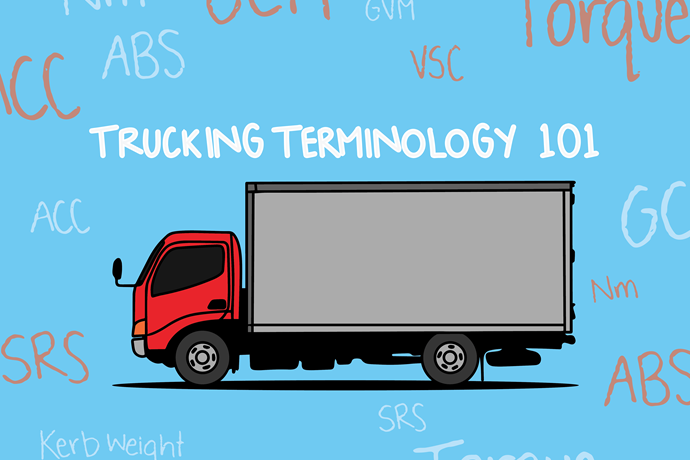
Every industry has its own language, or lingo (if you like), and the transport industry is no exception. If you’re already in the industry in some form or another, there’s a good chance you might be fluent in ‘truckie talk
However, maybe you’re an apprentice, a new truckie, or someone looking to purchase their first truck and could do with some insider help to arm yourself before you head into your local dealership.
If that’s the case, don’t worry, we’ve got your back.
We’ve created a ‘cheat sheet’ of terminology. This features some of the most common terms when it comes to trucks. And, here’s a little fun fact… not only are most of the safety features below great at reducing road accidents, but most of them are part of our Hino SmartSafe package; a safety package designed to keep you and other road users safe, which comes as standard on all of our models.
Now, let’s get stuck in and arm you with some highly useful information you can use when having a chinwag with others in the industry, or chatting with your local Hino dealer.
Gross Vehicle Mass (GVM)
The GVM is the maximum weight that a truck can carry including its own weight. This is the maximum or total weight of a loaded rigid vehicle (including body, accessories, payload, fuel and driver).[EH1]
Gross Combination Mass (GCM)
This is the maximum weight a truck can carry and tow. This includes passengers, equipment, payload, fitted accessories, fuel and tools.
Vehicle Stability Control (VSC)
VSC uses the brakes to help steer should your vehicle begin to slip or spinout by applying the brakes to individual wheels, countering over or understeer. Some systems are known to reduce engine power to help counteract these situations.
Kilowatt (kW).
Kilowatts, or kW is the metric rating that describes how powerful an engine is.
Torque / Newton Metre (Nm)
NM, or Newton Metres is the metric rating of Torque that describes how flexible or how much force can be expressed in a given gear by an engine.
Autonomous Emergency Braking (AEB)
The Autonomous Emergency Braking (AEB) system uses front mounted radar technology to measure the distance between your vehicle and the one in front and can activate your brakes if you don’t react in time.
Anti-lock Braking System (ABS)
Before the introduction of radar sensors and AEB (see above), if you had to slam down your brakes to avoid a collision, there was a good chance all your wheels could lock up and cause you to lose control. To reduce this risk, drivers were advised to ‘pump’ their brakes to stop their wheels locking. ABS automates the brake pumping to allow the driver to focus on steering the vehicle out of danger.
Adaptive Cruise Control (ACC)
ACC works the same as your everyday Cruise Control by allowing you to set your cruise speed. The difference is the use of radar technology to determine when the vehicle in front slows down. The ACC will slow your vehicle to match their speed and then speed up once they are no longer in your radar’s sensor range. It also reduces fatigue and can improve overall fuel efficiency. Pretty handy!
Supplemental Restraint System (SRS)
SRS, or Supplementary Restraint System, is an additional safety restraint over and above basic seatbelts, such as airbags. Using a variety of sensors located in the vehicle, when triggered, the SRS airbag will deploy to reduce driver and passenger injury.
Kerb Weight (Tare)
Similar to its cousins (GVM and GCM) mentioned above, Kerb Weight and Tare are about the weight of a vehicle, but with a few differences. Kerb Weight is the weight of a standard vehicle with a full tank, but no fittings or accessories. While Tare Weight is the weight of the vehicle with all fluids, but only 10 litres of petrol.
There you have it. Our go-to ‘cheat sheet’ for anyone looking to learn more or brush up on their trucking terminology. So, whether you’re looking to just hold a conversation, or be armed with knowledge before walking into a dealership, we trust we’ve done the job.
You can also check out our website to read up on all the features and benefits of purchasing a Hino vehicle.
However, if you want a more in-depth read on other trucking terms, you can visit our two ‘A guide to trucking terminology’ blogs here and here.